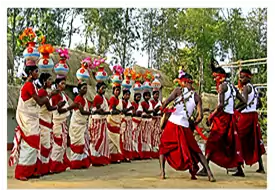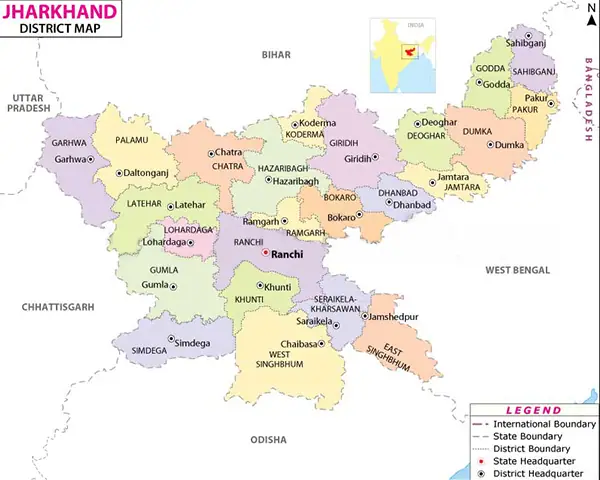List of important folk dances of Jharkhand:
Chhau Dance: folk dances of Jharkhand
- Popular Chhau dance of Jharkhand has a unique identity.
- UNESCO included this form of dance in Heritage Dances in year 2010.
- This is a male dominated dance which is performed with mask or without mask.
- To attack or to hunt secretly is also a description of this dance.
- Chhau dance, originating from Jharkhand is now integrated in the cultures of Odisha and West Bengal. This dance has become a part of the cultures of these three states.
- There are four varieties of this dance – Saraikela Chhau (Jharkhand), Mayurbhanj Chhau (Odisha), Purulia Chhau (West Bengal) and Singua Chhau of Khunti District of Jharkhand.
Paika Dance: folk dances of Jharkhand
- In the tribal community of Jharkhand, Paika Dance is usually performed to welcome special respected guests or during religious procession (Shobha Yatra).
- This Dance symbolishes battle-art.
- The dancing artiste holds a shield (Dhal) in his left hand and a two edged sword in his right hand.
- His dresses are bright, attractive and fitted with frills (Jhalar).
- Peacock wings (Pankh) is thrust in turban.
- To avoide falling of turban, colourfull cloth strips are tied on hands, elbows and chest in artistic manner.
- Due to coloured strips an impression of colourfull wings is created. This is why this is called Paika Dance.
- When pairs of three, five, seven, nine or eleven dancers dance together in uniformity, sound of ghunghroo and Paijan Creates a wonderful atmosphere.
Khadia Dance: folk dances of Jharkhand
- Khadia Community is a part of ‘Agneya’ family. But Khadias are not so close as Munda, Santhal and Ho are with one another.
- From cultural view, they have separate existence. Their dances continue round the year according to weather and speciality of occasion. In their dance too, collectivity is present.
- At a time, all relations of village-house are connected with cordial relation of dance and music, Khadia community, women dance in a row joining hand with each other. Sometimes, they also dance separately as well.
- Mandar, Nagara, Dhol etc are their favorite musical instrument.
- The male dance of Khadia community are Hario, Kinbhar, Halka, Doyor, Jadura, Jeth Lahsua, Jethwari, Thadia, Karma Thadia, Jethwari Thoylo, Jethwani Angani, Chait Baisakh Tndia, Lahsua, Sayalo etc.
जनगणना 2011 से झारखण्ड सम्बंधित प्रमुख तथ्य
Kadsa Dance: folk dances of Jharkhand
- Kadsa dance is a dance style performed carrying a ‘Kalasha’ (earthen pot).
- his is a female dominated dance.
- Normally in this dance style, women perform carrying a ‘Kalash’ on their shoulders or heads.
- Usually male are not included in this dance style. Men just play instruments. Whether it is a seasonal festival or welcoming a guest, this dance style match step by step with hopes of life.
- It is said about Jharkhand that here dance is walking and music is life. Kadsa is a dance, which expresses this sophisticated feeling beautifully.
Nagpuri Dance: folk dances of Jharkhand
- All dances of Jharkhand are primitive folk dances.
- All folk dances are traditional, which are inherited by tribal groups as heritage through centuries, primitive period and through generation to generation.
- Some of these traditional folk dances are slow and some are fast. Nagpuri dance style is a folk dance of mixed nature, which starts slowly and then becomes very fast.
- This dance is largely exhibited in Nagpuri films also. It would not be an exaggeration to describe this form of dance as the most modern folk dance
Birohr Dance: folk dances of Jharkhand
- Birhor Dance is a tribal folk dance from Jharkhand.
- When we celebrate the festival Deepawali the tribal Birhor who lived in the deep forests prepare for marriage of their young boys & girls.
- First they pray their God and then worship; after that the girls go to jungle bushes and then boys are released. Then their marriage takes place. After that this form of dance is performed in group by all Birhora.
Manbhum Chau: folk dances of Jharkhand
- The Manbhum Chhau is a martial art dance performed by mainly Kurmi community where the group of dancers use heavy masks and brightly coloured costumes and traditional ornaments to give an attractive look.
- The mask is used for depiction of character. Animated, fast movements and loud beats of drum recreate war like ambience while depicting mythological stories.
- They jump, take vault plays swords and dance. They normally perform in an arena called Akhda.
Mundari Dance: folk dances of Jharkhand
- The Munda society in Jharkhand has its own identity regarding their language and culture. Their dances also follow different ragas and rhythms throughout the year according to the change of seasons, which are also indicative of its festival, festival of festivals. On such occasions, no celebration is possible without dance music. Mundas are the main dances of the society. Jadur, Orjadur, Nirjadur, Japi, Gaina, Chitid, Chhava, Karam, Khemta, Jarga, Ojarga, Jatra, Paika, Buru, Fake dance etc.
- Their specialty is that men do not dance by joining the women’s troupe.
- The scope of the Mundari dance style is huge. Their life is constantly filled with ragas and raginis, from harvest to seasonality.
Santhali Dance: folk dances of Jharkhand
- The dance songs of Santhali are slightly different from those of other tribal dances.
- In a dance, women dance by moving their hands together, moving their hands on a particular step of straight steps with folded fists.
- Songs not sung in any dance, only instruments are played.
- The designation of Santhali dance is artistic.
- Their dress is also artistic. Women men wear green, catechu, four-color sari-dhoti, turban artfully.
- Sometimes in dance they move, jump, sometimes join, sometimes they break. They dance at different speeds in many different postures.
- Their dance music has an amazing charm. The Santhals also come from the Munda clan.
- There are fundamental differences in language culture even though there are substantial similarities. This change is evident in dance music.
Hunta: folk dances of Jharkhand

- This dance is performed on festival and special occasions by the Santhal tribes showcasing their strength of unity and pride.
- The dancers wear colourful costumes of dhoti and turban and decorate their body with various species of flora.
- They design their clothes and use branches, leaves and flowers along with their clothes as the Santhals are said to be close to nature.
- The dance depicts in mime form, the hunt with bows and arrows, stalking and killing the animal.
Karam (Karma): folk dances of Jharkhand
- This dance is derived from a sacred tree named Kadamba which is believed to bring prosperity and good luck to the people and depicts the celebration of the planting of the tree.
- It is performed during the Kadamb (Karam) festival in the month of August.
- This is one of the few dances in which women too are allowed to participate.
- The dancers form a circle and dance with their hands on each other’s waists while passing on a branch of the tree to each other.
- After one complete circle of passing the Karma branch, it is washed with rice and milk.
- The branch is not allowed to touch the earth after these rituals and it is once again raised between the dancers.
Barao: folk dances of Jharkhand
- This dance is performed by the Oraon community generally in the month of Baisakh (April – May) in an Akhada or performing area.
- Prayers are offered to Mother Earth for a good monsoon so that a rich harvest may be secured.
Jhenana Jhumur: folk dances of Jharkhand
- This dance is performed by the women of the Nagpuri and Santhal communities during all festivities and occasions especially during the harvest season.
Mardani Jhumur: folk dances of Jharkhand
- It is a semi martial art form performed by the men of the Nagpuri and Southern tribes. The musical instruments used for this dance are Dhol, Nagara, Shenai, Kartal and Jhanj. Some female dancers known as Nachnis also join this dance along with the men.
Jhitka and Danga: folk dances of Jharkhand
- This dance is performed by men and women and the headgear and costume worn are similar to those of the Paika dance. This dance expresses happiness and joy and celebrates different feudal traditions.
Lahasuya: folk dances of Jharkhand
- This dance is generally performed by men and women as a call to rain specially when there is a drought. It is accompanied by the madol or tumdak the double sided barrel drum.
Domkach
- Domkach is a folk dance of Indian states of Bihar and Jharkhand. In Bihar, Domkach dance is performed in Mithila and Bhojpur regions.
- In Jharkhand, it is Nagpuri folk dance.
- The women and men of groom’s and bridegroom’s family perform this dance during all major marriage ceremonies.
- They form a semi-circle to perform this particular dance by holding hands of each other and lyrics of the song are satirical and full of joy.
- Nagpuri domkach is further divided into Ekharia domkach, Dohri domkach and Jhumta. In Uttar Pradesh, it is a kind of festival.
Ghora naach: folk dances of Jharkhand
- This dance is performed by men during wedding ceremonies wearing loose horse puppets around their waists and they dance to the rhythmic beats of the folk instruments.
Also refer :
- झारखण्ड के प्रमुख वन्य जीव अभ्यारण्य एवं पक्षी विहार
- झारखण्ड का भौगोलिक परिचय
- झारखण्ड में प्रथम
- Download the pdf of Important MCQs From the History Of Ancient India
- List Of Important Inscriptions In India
- Know About Launch Vehicles Of ISRO



